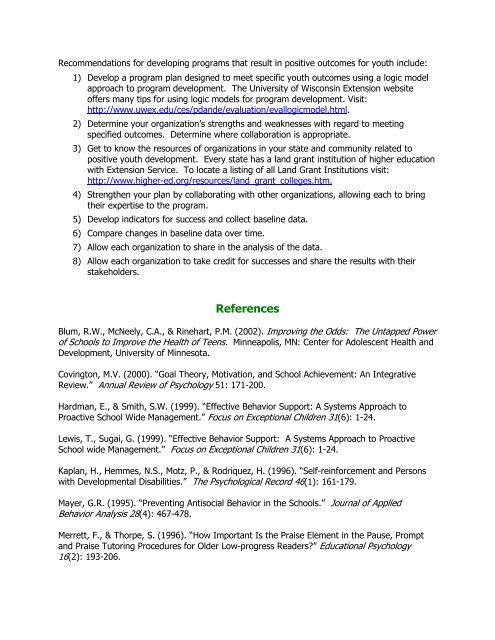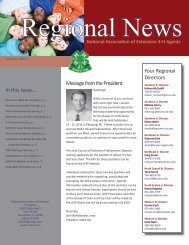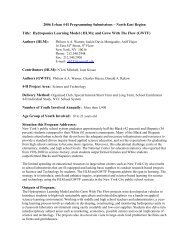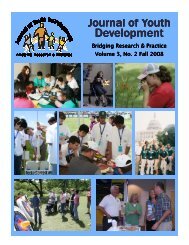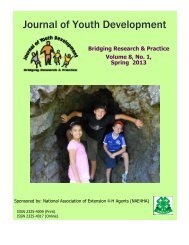Winter 2008 - Vol. 3 No. 3 - National Association of Extension 4-H ...
Winter 2008 - Vol. 3 No. 3 - National Association of Extension 4-H ...
Winter 2008 - Vol. 3 No. 3 - National Association of Extension 4-H ...
- No tags were found...
Create successful ePaper yourself
Turn your PDF publications into a flip-book with our unique Google optimized e-Paper software.
Recommendations for developing programs that result in positive outcomes for youth include:1) Develop a program plan designed to meet specific youth outcomes using a logic modelapproach to program development. The University <strong>of</strong> Wisconsin <strong>Extension</strong> website<strong>of</strong>fers many tips for using logic models for program development. Visit:http://www.uwex.edu/ces/pdande/evaluation/evallogicmodel.html.2) Determine your organization’s strengths and weaknesses with regard to meetingspecified outcomes. Determine where collaboration is appropriate.3) Get to know the resources <strong>of</strong> organizations in your state and community related topositive youth development. Every state has a land grant institution <strong>of</strong> higher educationwith <strong>Extension</strong> Service. To locate a listing <strong>of</strong> all Land Grant Institutions visit:http://www.higher-ed.org/resources/land_grant_colleges.htm.4) Strengthen your plan by collaborating with other organizations, allowing each to bringtheir expertise to the program.5) Develop indicators for success and collect baseline data.6) Compare changes in baseline data over time.7) Allow each organization to share in the analysis <strong>of</strong> the data.8) Allow each organization to take credit for successes and share the results with theirstakeholders.ReferencesBlum, R.W., McNeely, C.A., & Rinehart, P.M. (2002). Improving the Odds: The Untapped Power<strong>of</strong> Schools to Improve the Health <strong>of</strong> Teens. Minneapolis, MN: Center for Adolescent Health andDevelopment, University <strong>of</strong> Minnesota.Covington, M.V. (2000). “Goal Theory, Motivation, and School Achievement: An IntegrativeReview.” Annual Review <strong>of</strong> Psychology 51: 171-200.Hardman, E., & Smith, S.W. (1999). “Effective Behavior Support: A Systems Approach toProactive School Wide Management.” Focus on Exceptional Children 31(6): 1-24.Lewis, T., Sugai, G. (1999). “Effective Behavior Support: A Systems Approach to ProactiveSchool wide Management.” Focus on Exceptional Children 31(6): 1-24.Kaplan, H., Hemmes, N.S., Motz, P., & Rodriquez, H. (1996). “Self-reinforcement and Personswith Developmental Disabilities.” The Psychological Record 46(1): 161-179.Mayer, G.R. (1995). “Preventing Antisocial Behavior in the Schools.” Journal <strong>of</strong> AppliedBehavior Analysis 28(4): 467-478.Merrett, F., & Thorpe, S. (1996). “How Important Is the Praise Element in the Pause, Promptand Praise Tutoring Procedures for Older Low-progress Readers?” Educational Psychology16(2): 193-206.


